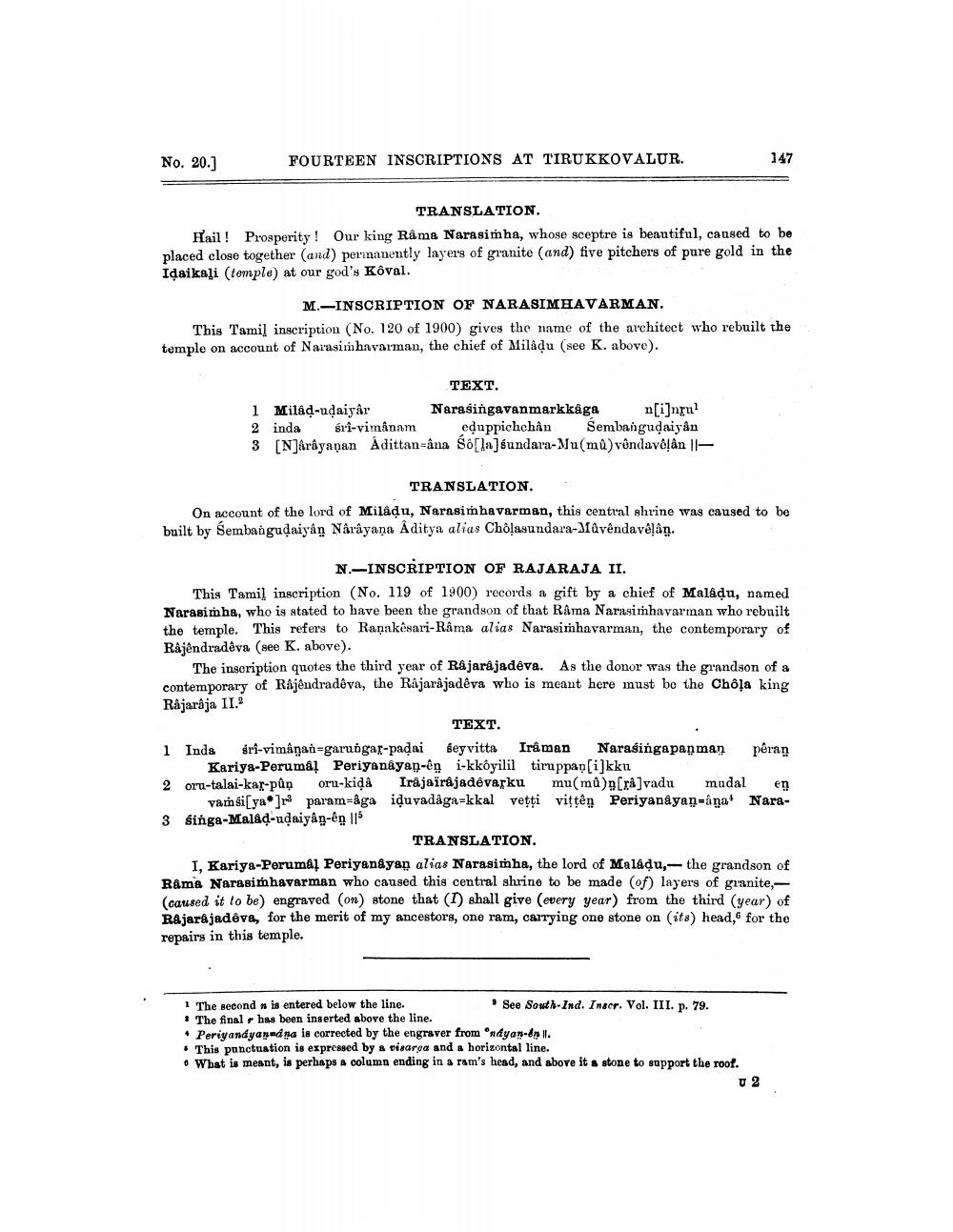________________
No. 20.)
FOURTEEN INSCRIPTIONS AT TIRUKKOVALUR.
TRANSLATION. fail! Prosperity! Our king Rama Narasimha, whose sceptre is beautiful, caused to be placed close together (and) perinanently layers of granite (and) five pitchers of pure gold in the Idaikali (temple) at our god's Kôval.
M.-INSCRIPTION OF NARASIMHAVARMAN. This Tamil inscription (No. 120 of 1900) gives the name of the architect who rebuilt the temple on account of Narasimhavarman, the chief of Milådu (see K. above).
TEXT. 1 Milad-udaiyar Narasingavanmarkkåga n[i]nru? 2 inda śr-vimânam eduppichchan Sembangudaiyan 3 [Narayanan Adittan-ana So[la]sundara-Mu(mů) vondavolån ||
TRANSLATION. On account of the lord of Miladu, Narasimhavarman, this central shrine was caused to be built by Sembangudaiyan Narayana Aditya alias Cholasundara-Mavendavélån.
N-INSCRIPTION OF RAJARAJA II. This Tamil inscription (No. 119 of 1900) records a gift by a chief of Maladu, named Narasimha, who is stated to have been the grandson of that Rama Narasimhavarman who rebuilt the temple. This refers to Ranakesari-Rama alias Narasimhavarman, the contemporary of Råjendradêva (see K. above).
The inscription quotes the third year of Rajarajadêva. As the donor was the grandson of a contemporary of Rajendradêva, the Rajarajadêva who is meant here must be the Chola king Rajaraja II.
TEXT. i Inda eri-vimaŋan-garungar-padai seyvitta Iraman Narasingapanman pêran
Kariya-Peruma! Periyankyan-ên i-kköyilil tiruppan[i]kku 2 oru-talai-kar-půņ oru-kida Irajaïrajadêvapku mu(mů) Crå]vadu mudalen
vamsi ya*]r param=åga iļuvadåga=kkal vetti vittén Periyanåyan-âņaNara3 singa-Malad-udaiyân-ên 115
TRANSLATION. I. Kariya-Perumal Periyanêyan alias Narasimha, the lord of Maladu,- the grandson of Ráma Narasimhavarman who caused this central shrine to be made of) layers of granite, - (caused it to be engraved (on) stone that (1) shall give every year) from the third (year) of R&jarajadêve, for the merit of my ancestors, one ram, carrying one stone on (it) head, for the repairs in this temple.
The second n is entered below the line.
* See South-Ind. Inscr. Vol. III. p. 79. • The final r has been inserted above the line. · Periyandyaxedna is corrected by the engraver from `ndyan-& II. * This ponctuation is expressed by & visarga and a horizontal line. o What is meant, is perhaps & column ending in a ram's head, and above it a stone to support the roof.
u 2




